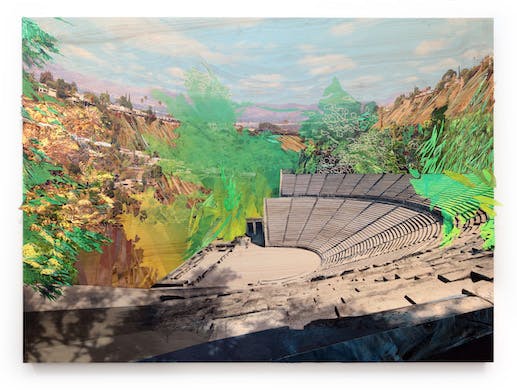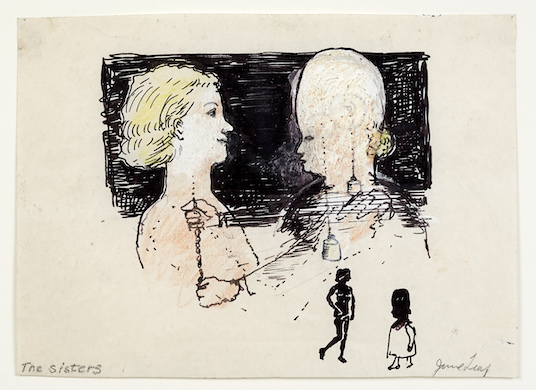Manhattan Galleries Presenting Dynamic Duos
The elusive promises of mass culture are an undercurrent both artists share in C24 Gallery’s ‘Rites of Passage: Cheryl Molnar and Christian Vincent,’ as is an abiding respect for their materials.

‘Rites of Passage: Cheryl Molnar and Christian Vincent’
C24 Gallery, 560 West 24th St., until July 14
‘June Leaf & Kyle Staver: Drawings’
Steven Harvey Fine Art Projects, 208 Forsyth St., until June 24
Pair the work of any two artists, and you can’t help but contrast and compare. Attempts to locate some kind of commonality of vision or process, as well as (gulp) differentiations in aesthetic worth, are an inherent part of such a venture. Just try to avoid weighing the works of Juan de Pareja against those of Diego Velazquez while attending the Met’s “Juan de Pareja; Afro-Hispanic Painter,” or doing the same with the headliners in MoMA’s “The Encounter: Barbara Chase-Riboud/Alberto Giacometti.” It’s impossible.
The same goes for a pair of two-person shows recently opened at Manhattan. On the Lower East Side, Steven Harvey Fine Art Projects is exhibiting the drawings of June Leaf and Kyle Staver, while in Chelsea, C24 Gallery has mounted “Rites of Passage: Cheryl Molnar and Christian Vincent.” Is it possible to glean just what it was that prompted these venues to devote themselves to their respective dynamic duos?
“Rites of Passage” seems the iffier venture thematically. What might Ms. Molnar’s unpeopled panoramas of the American landscape share with Mr. Vincent’s expositions on middle-class dysphoria? Although Mr. Vincent employs oils on canvas, he does share with Ms. Molnar an emphasis on the collage aesthetic. The piecemeal nature of Mr. Vincent’s canvases — what with their discrepancies in scale, space, and image — are congruent with Ms. Molnar’s accumulations of gouache, digital prints, and the grain of the wood panels on which she works.
There’s that, along with a strain of Surrealism that is more overt in, say, the moody vista seen in Mr. Vincent’s “False Night” (2021) than in Ms. Molnar’s “Remnant” and “Boulevard” (both 2023), wherein the otherworldly — or, rather, the denatured — is evoked through an overriding sense of isolation. In the end, the elusive promises of mass culture are an undercurrent both artists share, as is an abiding respect for their materials. In that regard, Ms. Molnar, who has a deft way with slicing-and-dicing, proves especially skillful.

June Leaf and Kyle Staver, in contrast, abjure popular culture for the byways of myth and allegory. Born in 1929, Ms. Leaf is a painter and sculptor who has long pursued an idiosyncratic brand of figuration. Like not a few generations of artists from Chicago, Ms. Leaf traverses the eccentric and the existential as if they were her birthright: Think Giacometti with a dash of Calder. Notwithstanding the sometimes frazzled nature of her process, Ms. Leaf’s line achieves an elegance that, at particularly satisfying moments, recalls the sinuous contours found in Egyptian relief sculptures.
If Ms. Leaf traverses no man’s lands, Ms. Staver sticks with stories that will ring a bell for classics majors: St. George, Salome, Hercules, and Christ figure into the drawings. Ms. Staver’s work is rambunctious in form and approach: her figures are gawky and cartoonish, and her use of oil pastel, watercolor, and other media appealingly direct. The distinctive light she yokes from working with oils on canvas is missed. Nonetheless, even at her most off-hand, and here I think especially of the lyrical equipoise of “Ascension” (2018), Ms. Staver’s brevity proves worthy of her source material.
How well syncopated are the drawings of Ms. Leaf and Ms. Staver? They share a format — the majority of the pieces are done on 8-½ x 11-inch sheets of printing paper — and an emphasis, notably if not exclusively, on the female form. The installation at Harvey could’ve been less higgledy-piggledy and, perhaps, more discriminating in selection. (Not everything an artist turns to gold — unless, that is, you’re Degas.) But abundance does suit two artists whose imaginative excess is well-matched by their formal acuity, which is reason enough, as it turns out, to put the work on display.

